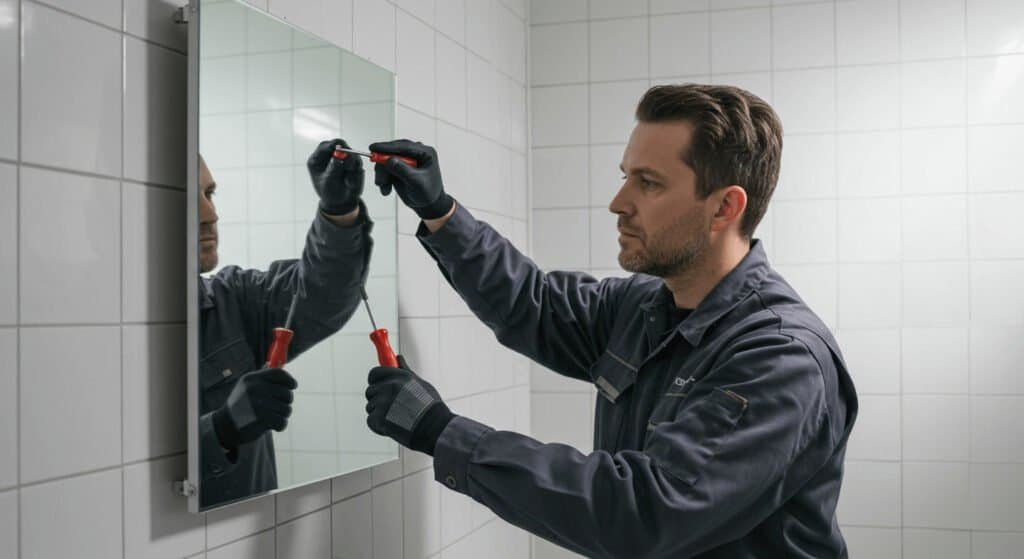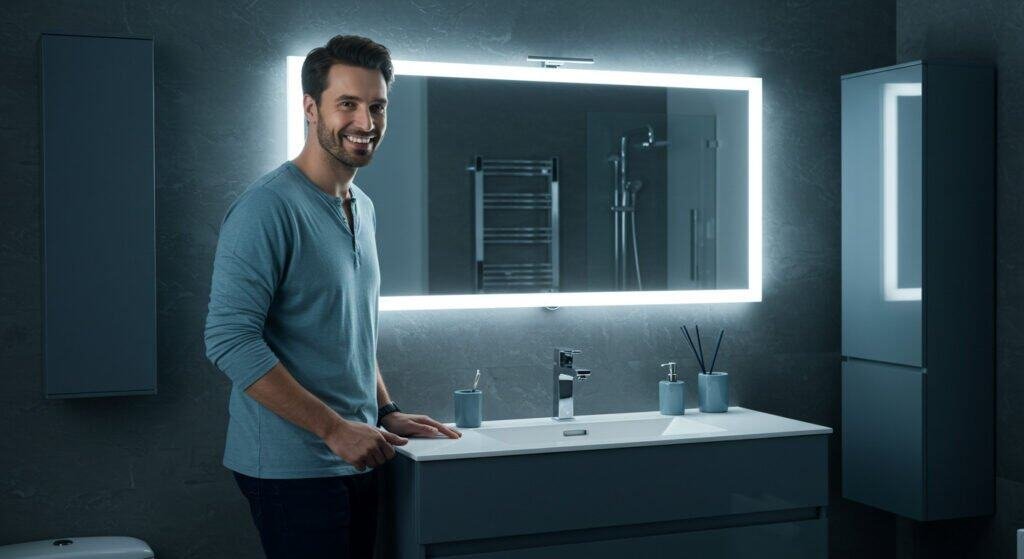Removing a large bathroom mirror presents significant challenges that can result in costly damage and safety hazards. Without proper technique, your expensive glass mirror could shatter, causing injury and leaving you with cleanup costs and replacement expenses. So,how to remove a large bathroom mirror?
The standard approach involves gathering protective equipment, identifying the mounting method, applying appropriate removal techniques, and safely disposing of the mirror. Essential tools include safety glasses, gloves, painter’s tape, a utility knife, and assistance from another person to handle the weight and size of large bathroom mirrors.
Understanding these professional techniques will help you avoid common mistakes and complete the removal process efficiently.
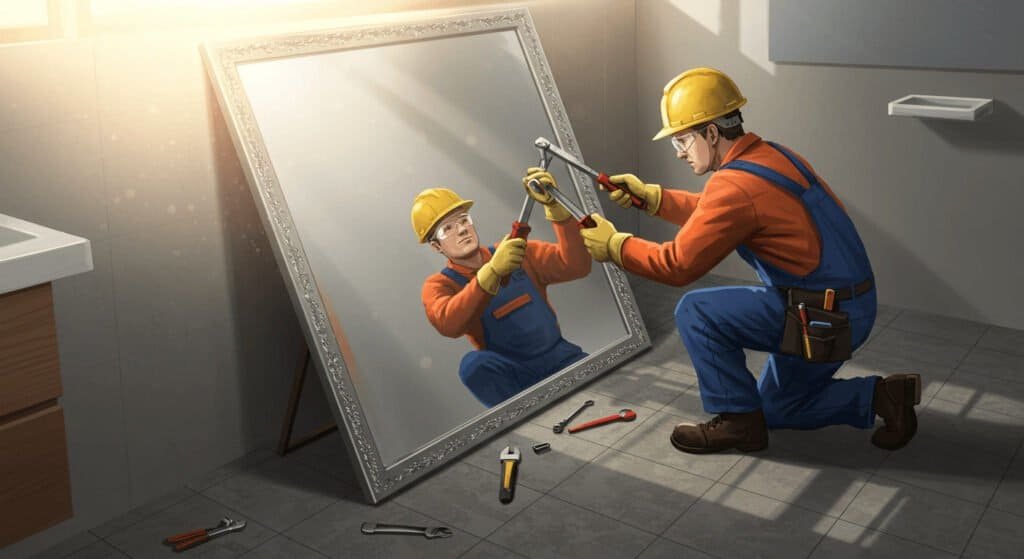
How to Remove a Large Bathroom Mirror from a Wall: Essential First Steps
Before you begin the mirror removal process, make sure you’re prepared and know what you’re getting yourself into.
Begin by clearing the bathroom area, protecting surfaces with drop cloths, and ensuring adequate lighting. Turn off electricity to nearby bathroom vanity lights and led vanity mirror systems to prevent accidental contact with wiring during removal.
The preparation phase extends beyond simple cleanup. Modern lighted mirrors for bathrooms often connect to electrical systems, requiring careful disconnection of power sources. If you are working with an led bathroom mirror or backlit mirror, locate the electrical junction box and safely disconnect the wiring following local electrical codes.
Document wire connections with photographs before disconnection to facilitate future installation. Protective measures include applying painter’s tape in an X-pattern across the mirror surface to contain glass fragments should breakage occur. Position furniture and fixtures away from the work area, and ensure you have a clear path for mirror transportation once removed.
How to Remove Large Bathroom Mirrors with Screw Attachments
Mechanically fastened mirrors require systematic approach to avoid wall damage.
Locate all mounting points by examining the mirror perimeter and checking for screw heads or mounting brackets. Use appropriate screwdrivers to remove fasteners while supporting the mirror weight throughout the process.
Screw-mounted systems present the most straightforward removal process among attachment methods. Begin by identifying all mounting points, which typically appear along the mirror edges or behind decorative trim around bathroom mirror installations. Lighted makeup mirror and vanity mirror with led lights systems often feature additional mounting points to support electrical components and transformers.
Remove screws gradually, starting from the top and working systematically to maintain mirror stability. Support the mirror weight continuously during fastener removal, as mechanical failure can occur suddenly once critical support points are removed. Document screw locations and lengths for future reference, particularly important when planning replacement with modern lighted mirrors for bathrooms or upgraded led bathroom mirror systems. Clean screw holes and mounting surfaces after removal to prepare for new installations.
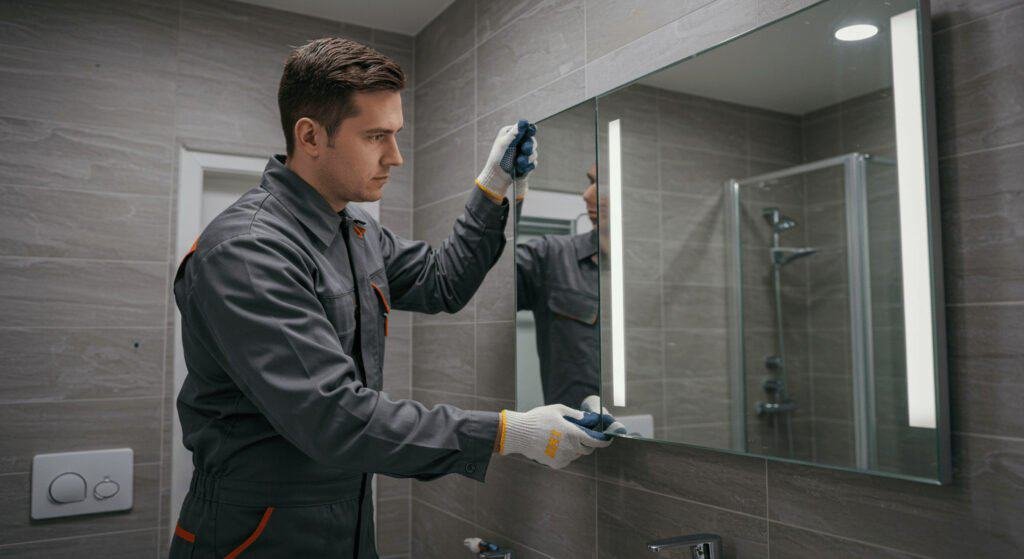
How Large Mirrors Are Attached to Wall Systems
Understanding mounting methods determines your removal strategy and required tools.
Large bathroom mirrors typically use three primary attachment methods: construction adhesive, mechanical fasteners such as screws and brackets, or specialized mirror clips. Each method requires specific removal techniques and tools for safe extraction.
Modern bathroom mirror installations vary significantly based on mirror type and installation preferences. Traditional glass mirrors often rely on construction adhesive applied directly to the wall surface, creating a permanent bond that requires careful separation techniques. Contemporary led light mirror vanity systems and lighted vanity mirrors for bathroom applications frequently employ mechanical mounting systems that distribute weight across multiple attachment points.
These systems accommodate the additional weight of electrical components and led vanity mirror hardware. Hybrid installations combine adhesive backing with mechanical fasteners for enhanced security, particularly common with rectangular bathroom mirrors and larger modern bathroom mirror designs. Understanding your specific mounting system prevents damage during removal and guides tool selection for the project.
| Mirror Type | Common Mounting Method | Primary Tools Needed | Estimated Removal Time |
|---|---|---|---|
| Standard Glass Mirror | Construction Adhesive | Heat gun, putty knife, wire | 2-3 hours |
| LED Mirror | Screws and brackets | Screwdriver, wire nuts, voltage tester | 1-2 hours |
| Lighted Vanity Mirror | Combination mounting | Multiple tools, electrical equipment | 2-4 hours |
| Small Bathroom Mirror | Mirror clips | Screwdriver, pliers | 30-60 minutes |
Removing Adhesive-Mounted Large Bathroom Wall Mirrors
Adhesive removal requires patience and proper technique to prevent mirror breakage and wall damage.
Apply controlled heat using a hair dryer or heat gun to soften construction adhesive. Work gradually from one corner, using thin wire or fishing line to separate the mirror from the wall surface while maintaining steady pressure.
Adhesive-mounted mirrors present the greatest challenge in removal projects due to the permanent nature of construction adhesives used in bathroom environments. Professional installers often use marine-grade adhesives that maintain bond strength despite humidity exposure, making separation difficult without proper technique. Begin heating at one corner of the mirror, focusing heat application on small sections to avoid thermal stress that could cause glass failure.
Work a thin wire behind the heated section, maintaining constant gentle pressure to separate adhesive bonds gradually. This technique proves particularly important with expensive backlit mirror and light up vanity mirror installations where replacement costs are significant. Monitor progress carefully, as rushing the process increases breakage risk and potential injury. Some installations may require adhesive solvents for complete removal, though heat and mechanical separation typically prove sufficient for most residential applications.

Can you hang any type of mirror in a bathroom?
Bathroom-specific requirements influence mirror selection and long-term performance expectations.
Yes, most mirror types can function in bathroom environments, though moisture resistance and electrical safety requirements vary significantly. Specialized bathroom mirrors offer enhanced durability and safety features compared to standard wall mirrors.
Bathroom environments present unique challenges that influence mirror selection and performance outcomes. High humidity levels, temperature fluctuations, and potential water exposure require mirrors with appropriate environmental ratings and protective features.
Standard room mirror ideas may not translate effectively to bathroom applications without consideration of moisture resistance and safety requirements. Modern bathroom mirror designs incorporate protective backing materials and sealed edges to prevent moisture infiltration that can cause silvering degradation over time.
Electrical mirrors, including led light mirror vanity systems and backlit mirror installations, require additional safety certifications such as UL listing for wet location use. These specialized requirements ensure safe operation in bathroom environments while maintaining long-term functionality and appearance. Consulting with electrical professionals ensures proper installation and compliance with local building codes for powered mirror systems.
| Mirror Feature | Bathroom Suitability | Special Considerations | Typical Lifespan |
|---|---|---|---|
| Standard Glass | Good | Requires moisture seal | 10-15 años |
| LED Lighting | Excellent | UL wet location rating required | 8-12 años |
| Heated Demist | Excellent | Professional installation recommended | 12-18 años |
| Magnification | Good | Limited to small sections | 8-10 años |
Are All Bathroom Mirrors Secured with Adhesive Methods?
Mirror mounting methods vary based on size, weight, and electrical requirements of different mirror types.
Not all bathroom mirrors use adhesive mounting. Small bathroom mirror installations often rely on clips or brackets, while wall mirror with lights systems typically require mechanical fasteners to support additional weight and electrical connections.
Contemporary mirror installation practices have evolved beyond traditional adhesive-only methods, particularly with the introduction of advanced lighting systems. Standard bathroom vanity mirrors under thirty pounds often use construction adhesive for permanent installation, while larger mirrors with black frame designs typically require mechanical support systems.
Led mirror installations necessitate removable mounting methods to accommodate maintenance and electrical servicing requirements. Lighted vanity mirrors for bathroom applications combine multiple mounting approaches, using mechanical fasteners for primary support and supplemental adhesive for vibration dampening.
Understanding these variations helps property owners select appropriate mirrors and plan for future removal or replacement needs. Professional installers increasingly favor mechanical mounting systems for their serviceability and reduced wall damage during removal processes.
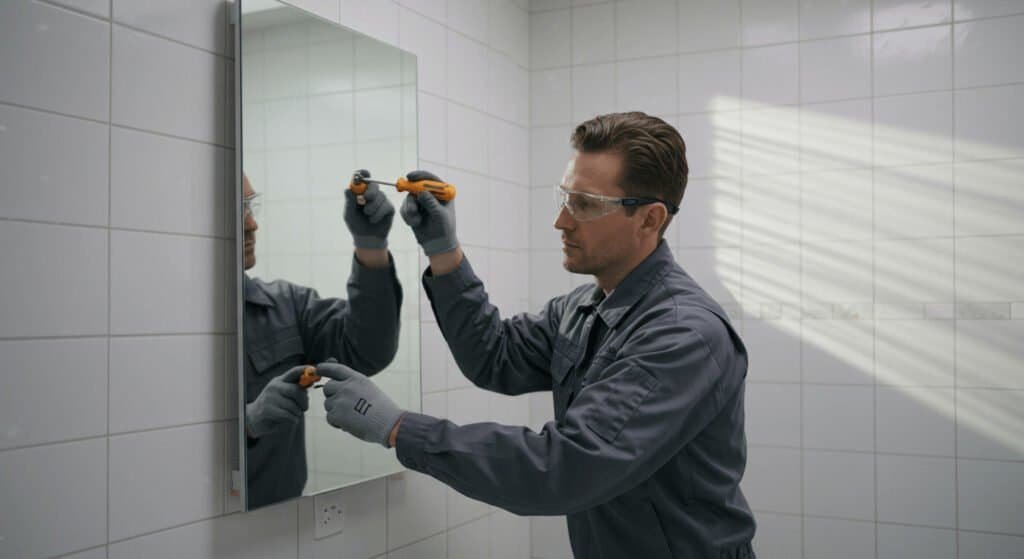
Proper Disposal and Recycling Methods for Large Mirrors
Responsible disposal protects the environment and complies with local waste management regulations.
Contact local waste management authorities to determine mirror disposal requirements, as many areas classify large mirrors as special waste requiring specific handling procedures. Consider donation or resale options for functional mirrors to reduce environmental impact.
Large mirror disposal involves several considerations beyond simple trash collection due to safety and environmental factors. Many municipalities require special handling for mirrors exceeding certain dimensions due to potential injury risks to waste management personnel. Functional mirrors, including older bathroom vanity lights systems and traditional glass mirrors, often find new homes through donation programs or resale platforms, reducing landfill impact while providing value to other property owners.
Broken mirrors require careful packaging in rigid containers with clear labeling to prevent injury during collection and processing. Some areas offer specialized glass recycling programs that accept mirror glass, though silvered backing materials may require separation before processing. Research local options thoroughly, as improper disposal can result in fines and environmental harm.
What is the difference between a vanity mirror and a wall mirror?
Different mirror types require specific removal approaches based on their design and mounting characteristics.
Vanity mirrors typically feature integrated lighting, magnification elements, or articulating arms that require electrical disconnection and specialized removal techniques. Wall mirrors generally use simpler mounting methods but may present size and weight challenges during removal.
The distinction between vanity mirrors and wall mirrors extends beyond simple categorization to encompass functional differences that impact removal procedures significantly. Traditional lighted vanity mirror systems incorporate electrical connections, transformers, and often mechanical adjustment mechanisms that require systematic disconnection before removal.
These systems frequently feature modular designs allowing component-specific removal, particularly beneficial when upgrading to newer led vanity mirror technology. Wall-mounted bathroom mirrors typically emphasize size and coverage area, with mounting systems designed for permanent installation and minimal maintenance access.
The cost to remove bathroom mirror installations varies accordingly, with simple wall mirrors requiring basic tools and techniques while complex vanity systems may necessitate electrical expertise and specialized equipment. Understanding these distinctions helps property owners budget appropriately and select qualified professionals when needed for safe removal and installation procedures.
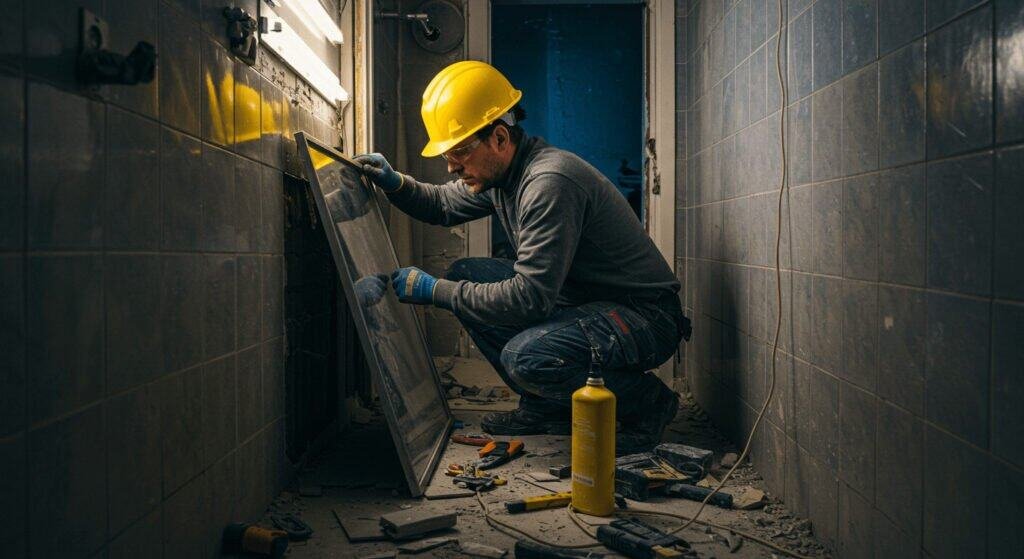
Conclusion
Professional mirror removal ensures safety while protecting your investment in bathroom renovations. Whether dealing with traditional glass mirrors or modern led lighting systems, following proper procedures prevents injury and property damage while preparing your space for upgraded installations.
- Clik here to know What Is Copper Free Mirror?
- If you donot know how too choose the right bathroom height click here.
- Know more about LED bathroom mirror Problems
- Clik here to know why Touch Sensor Mirror Not Working
- Clik here to know What Are Standard Vanity Mirror Sizes?
- Clik here to know Why Are Mirrors So Expensive?
- Clik here to know Do LED Mirrors Need Electricity?
- Clik here to know Is a Lighted Mirror Enough Light for a Bathroom?
- Find out 10 Common LED Bathroom Mirror Problems Click Here

